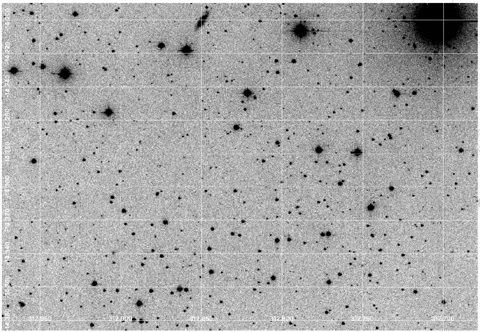This summer, the European Space Agency’s Near-Earth Object Coordination Centre (NEOCC) started posting “riddles” or challenges on their website. These riddles provide a look at how difficult it is for astronomers to find faint, near Earth objects (NEO). Try it for yourself by looking at the animation below:

Unless your eyes are used to quickly seeing changes/movement, this can be hard! This is a series of four images taken by a 1-meter telescope in Tenerife, Spain that the NEOCC uses for follow up observations of near Earth objects that have already been discovered. These secondary observations provide more data to better understand the size and orbit of the NEOs and to see if there’s any chance of an object hitting Earth.
This animation is from July 24, 2020 when an asteroid, now named 2020 OM3, showed up as a faint speck of light in four images taken between 2:46 UT and 3:36 UT. During these 50 minutes it had crossed a significant part of the telescope’s field of view, making it quite a challenge to spot.
Can you see any moving objects? The NEOCC provided these hints: there are three moving objects. The four exposures are repeated in an endless loop and tiny dots can be seen hopping in a straight line. Another big hint: 2020 OM3 is the fastest of all moving objects, and it’s also the faintest.
The challenge is to discover the moving objects.
• If you find any, send ESA the approximate start and end positions of each asteroid using the numbers on the horizontal and vertical axes to create coordinates.
• Bonus question: can you provide the official names of the objects that you’ve found?
For more challenges, the NEOCC has three previous riddles you can try (found at this link) where the answers are already available.
The NEOCC coordinates the network of European near-Earth object data sources and information providers, using this information gathered from across the globe to provide orbital information, impact monitoring, data provision and risk analysis, evaluating and monitoring the threat posed by asteroids and comets that come near Earth.
ESA says that about 95% of all near-Earth objects larger than 1 kilometer in size – the huge, mass-extinction-sized space rocks that roam the Solar System – have been found. But the smaller but still dangerous NEOs that are larger than 30 meters in size have been elusive. Astronomers estimate about 2 million of these objects exist, but only about 18.000 have been detected so far. This is because they are very faint and only become observable as they get close to Earth.
Check out one of our previous articles about how many asteroids are out there (hint: A LOT).

